Rowena Wiseman's Blog
May 23, 2023
5 top tools for authors

My absolute favourite 5 top tools for authors to help you write your book and promote it. From creating an author website in minutes, to using the best novel writing software, to an app where you can sell your ebooks straight from the link in bio.
Create an author website in minutes with AI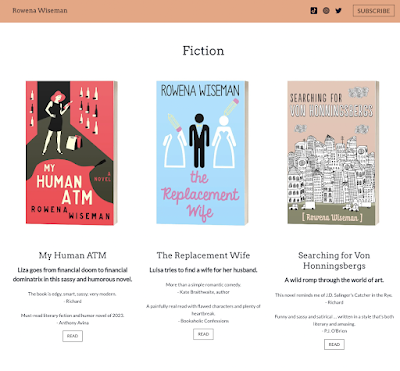
Use AI to create an author website in minutes. This AI website builder lets you build a website with artificial intelligence in 30 seconds. Simply enter your business type (writing), name of your business, and it will generate a beautiful website for you.
You can then customise the text and images, change the colour palette and create your own unique author website to showcase your books and sell more books to readers.
At only $12 a month, it's a quick, easy and cheap way to run your own attractive author website. Click here to try.
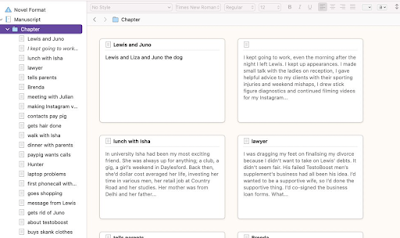
Scrivener is the best book writing software. Plan each chapter easily, zoom out and see your story as a whole and drag and drop sections at a time.
At a one-off fee of $77, which includes any upgrades, it's far more cost effective than other subscriber model novel writing software on the market. It is one of the best novel writing software for Mac or Windows.
Write and edit like a pro with ProWritingAid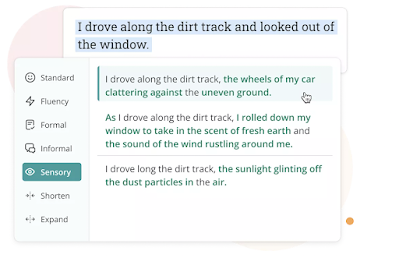 Power up your prose and improve your writing quickly. Grammar, spelling and readability improvements, like your own personal editor.
Power up your prose and improve your writing quickly. Grammar, spelling and readability improvements, like your own personal editor.Get 20% off with this link .
Jasper AI content marketing writer
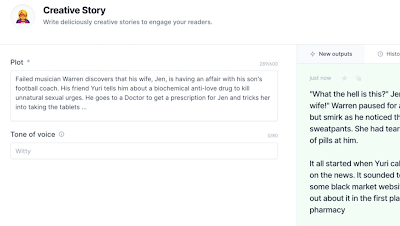
Have more time to write fiction while AI writes your blog articles, social media posts, website copy, and more.
Get a free trial by clicking on this link .
eBook creator via link in bio
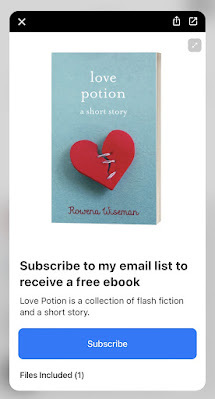
This little app is a game changer for writers. You can create ebooks where people can purchase directly from your link in bio on your favourite social media accounts. No sending them somewhere else to purchase your book. They can purchase it quickly and easily right there.
It also has a subscribe to download feature so that you can create an ebook incentive for people to sign up to your newsletter and they subscribe and download right there. Less clicks, and less chance of losing a new reader.
Sign up here to try out.
It's so exciting to see so many new apps to make a writer's job easier, so that we can spend more time on what we really love - and that is writing books.
May 21, 2023
Take your own author headshot and boost your book sales

There are three things you'll need when having a book published: an author bio, a blurb and an author headshot. As much as readers love to read your words, they're also going to be curious about what you look like, and your author photo can say a lot about you.
I looked into having a professional take my author photo, but I find it hard to relax in front of someone taking my picture! I end up tight lipped and looking slightly deranged.
I've worked out a cheap and easy way to take a professional looking author headshot with just my iPhone, s self-timer app and editing software. I've put together an ebook on how to take your own author headshot in 8 easy steps.
The ebook also includes 7 easy steps to edit your photos to come up with one favourite author headshot that you'll actually be proud of.
This how to guide is quick and easy to follow and will teach you how to take lots of photos quickly, change and mix up poses, and then select your favourite ones.
It will talk about how to present yourself (literary and serious, or fun and frivolous), how to find the perfect light and look your best.
Pose like no one is watching and optimise your author photos
The trick to getting the perfect author headshot is to take a lot of photos all at once and to change up your pose. In my how to take your own author headshot ebook, I explain how to use a self-timer to take tonnes of photos of yourself in different poses in minutes.

You can then choose your favourite photos and edit them using my 7 steps for editing to come up with the perfect author headshot.
Go from this author headshot:

To this:

Buy the ebook and learn how to take your own author headshot:
Everything you need to know to take a natural and candid author headshot that readers are going to love.
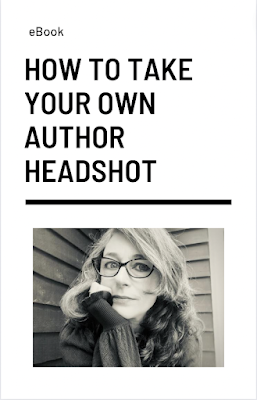
Click here to read: HOW TO TAKE YOUR OWN AUTHOR HEADSHOTEbook is only $5
15 steps to take your own author headshot

There are three things you'll need when having a book published: an author bio, a blurb and an author headshot. As much as readers love to read your words, they're also going to be curious about what you look like, and your author photo can say a lot about you.
I looked into having a professional take my author photo, but I find it hard to relax in front of someone taking my picture! I end up tight lipped and looking slightly deranged.
I've worked out a cheap and easy way to take a professional looking author headshot with just my iPhone, s self-timer app and editing software. I've put together an ebook on how to take your own author headshot in 8 easy steps.
The ebook also includes 7 easy steps to edit your photos to come up with one favourite author headshot that you'll actually be proud of.
This how to guide is quick and easy to follow and will teach you how to take lots of photos quickly, change and mix up poses, and then select your favourite ones.
It will talk about how to present yourself (literary and serious, or fun and frivolous), how to find the perfect light and look your best.
Pose like no one is watching and optimise your author photos
The trick to getting the perfect author headshot is to take a lot of photos all at once and to change up your pose. In my how to take your own author headshot ebook, I explain how to use a self-timer to take tonnes of photos of yourself in different poses in minutes.

You can then choose your favourite photos and edit them using my 7 steps for editing to come up with the perfect author headshot.
Go from this author headshot:

To this:

Buy the ebook and learn how to take your own author headshot:
Everything you need to know to take a natural and candid author headshot that readers are going to love.

Click here to read: HOW TO TAKE YOUR OWN AUTHOR HEADSHOTEbook is only $5
September 22, 2022
BookVolts - literature NFTs and blockchain books

I caught up with James Faktor, co-founder of BookVolts, a groundbreaking publisher and platform for Digital First Editions. BookVolts are using blockchain technology to create NFT books and bonus material. James tells us about the future of literary NFTs, how authors can create an NFT book, how they can become a valuable asset for readers and most importantly, how they offer a decentralized alternative to the current publishing industry.
What can BookVolts offer readers that hasn’t existed before?Right now BookVolts can offer readers the chance to own Limited First Editions in a digital format, something not previously possible before blockchain development. With a digital version comes the possibility for readers to own a 'live' edition of a book that can be updated and added to by the author when they wish. These updates could range from bonus material such as artwork, special messages, short stories, personal jottings and introductions to full blown announcements and rewards for fans that wouldn't be available elsewhere.
This kind of interaction leads to the possibility for owners of the Digital First Edition to seamlessly become part of a select community around the writer.
With blockchain being able to track each individual copy from owner to owner, the reader can also sell on their copy knowing that some of that sale will go back to the author. Therefore, they are endorsing both a form of purchase that rewards the author directly and fostering a secondary market that keeps supporting that author, previously impossible for print and ebook. BookVolts also offers readers the chance to consume all of the content available in a Digital First Edition through our newly developed Reader App which supports video, audio and animation, along with the epub file.
Essentially, we're giving readers the chance to actually own the digital book that they purchase with a clear digital code that unequivocally proves that ownership. With an Amazon ebook purchase, that ownership isn't clear - if Amazon went down or offline for some reason, you would lose your purchase.
NFT books work on a decentralised system that cannot be taken down or disputed.What type of bonus material do you imagine can be included with an NFT book?
Aside from the examples above, we imagine that authors will make an effort to engage with their fans through offering certain discounts on their books, as well as offering closer access to in person readings or events. They could even drop in a new chapter for a separate book, or even ask for direct feedback on a plot point or title. One of our fantasy authors that we've worked with included a glossary of terms, character analyses, and illustrated maps and history of the world in their books, but the possibilities are endless!
Do you expect the value of literary editions/NFTs to increase over time?Not necessarily - but that's OK! It's been a folly of NFT purchases recently for owners to assume that the prices will always rise without the bubble bursting. With NFT books, there's an actual asset to consider, so there will always be some value attached to it that's separate from pure speculation. If a new author does start to gain popularity through their work then their early Digital First Editions should gain significantly in value, especially if the author doesn't create any future editions to dilute the scarcity. Established authors should also be in this category if they pitch it correctly to their fanbase.
Then of course there will always be those from a crypto background who treat NFT's as a speculative investment and may view NFT books as the new hot thing to get on board with early. Either way, it's a great way for the author to earn some extra revenue for their work - The key is to not charge your fans a fortune for that first drop and instead allow the potential value raise to occur organically in the resales.

How are you hoping to work with authors and what type of original books and bonus material are you hoping to publish?
We hope that independent authors in particular will look to launch with us as we see no real downside to them marketing a Digital First Edition along with all of their other formats. The authors we are talking to so far have all spoken to at least some of their reader base about whether an NFT edition is something they'd appreciate, and so far the response has been positive. Authors who have their existing digital rights signed to a publishing house are a little more complicated, but even then it only takes an agreement between the author and the publishing house on how to split those NFT sales to go ahead.
We're currently bringing out a line of public domain books to show what our reader app can do, combining the text with new cover designs from some leading NFT artists. We hope to collaborate with authors to get the best out of their Digital First Edition, and we're currently building out the auction and review platform to allow for more of an interaction between new authors and potential fans to take place. In the future, we see NFT editions as another way for authors to get discovered, and with the smart contract setup allowing for multiple owners of a single edition, we see fans starting to stake their favourite up and coming authors to be part of their success.
______________________________________________
Start your crypto or literary NFT journey with $25 USD from crypto.com here to buy some crypto!
______________________________________________
How do authors submit their NFT idea to BookVolts and what can they expect during the publishing process?An author that gets in touch with BookVolts will be considered just like any other editorial process - we will look at the quality of the work and see if there is enough unique or selective material to justify an NFT edition. Once we approve the work we will collaborate with the author on what material to include, what kind of artwork should be adopted or created, and how many copies should be minted. This final discussion could be based on the existing fanbase that comes with the author, or it could be based on how much different content there is - some authors like to create Gold, Silver and Bronze editions with different bonus material for each, thus limiting the number of editions for the higher value NFT's. Once the number and a price has been decided upon, BookVolts does the minting.
BookVolts charges no fee for this service but instead takes 15% on the sale of the NFT books, and then 15% on any of the author's share of resales (generally 10%, so BookVolts would take 1.5%).
BookVolts will then announce the publication on our Twitter and Discord channels, and we are also in the process of growing a newsletter.
Finally, what would you say to sceptics to convince them about the future of literary NFTs?My impression is that NFTs in general have come in for a bad reputation due to the recent downturn in the crypto markets, and this has spread to the idea of NFT books being somehow toxic. However, these fluctuations in the crypto markets really have nothing to do with the value of an NFT book - they can easily be charged in 'real' currencies such as pounds and dollars, and they can be bought and sold just as easily as you would do a print book.
From a security standpoint, there is a worry around hacking, but this has always been an issue for any digital product and isn't a blockchain error but a human one. The technology itself is incredibly secure if the owners are careful with their wallets and who they give their details out to. Environmentally, the minting process has come a long way since the first iteration of Ethereum, so the carbon footprint of creating the editions has decreased massively. The cost of creation has also dropped to make it easily accessible to any author.
For those who think it's fool's gold, I would say it finally offers authors the chance to maximize the latent, untapped value of their work at a time when authors need that value most keenly!
On top of promoting to that existing fanbase, there's also the possibility of attracting new readers to the industry - just as the audio boom attracted podcast fanatics to a whole new genre, I believe that the rise of blockchain publishing could attract a whole wave of crypto enthusiasts to the publishing ecosystem.
James Faktor, co-founder of BookVolts
To find out more about BookVolts head over to https://bookvolts.com/
______________________________________________
Start your crypto or literary NFT journey with $25 USD from crypto.com here to buy some crypto!
______________________________________________
Sign up to receive a free 7-step action plan to become a published author!
- 3 resources to help you shape your story- how to increase productivity and focus- must have writing software - how to edit and revise like a pro- links to websites to find editors and publishers who are ACTUALLY SEEKING MANUSCRIPTS- automated tools to build an author platform- ideas for publishing in the digital revolution (yes, blockchain and NFTs!)#mc_embed_signup{background:#fff; clear:left; font:14px Helvetica,Arial,sans-serif; } /* Add your own Mailchimp form style overrides in your site stylesheet or in this style block. We recommend moving this block and the preceding CSS link to the HEAD of your HTML file. */
Subscribe
How to write a blog post in under 5 minutes with Copy AI

Copy AI wrote this blog post.
I'm the kind of person who likes to have a plan. I know that I need to write a blog post, but where do I start? How long should my post be? Are there any topics that are too broad or too specific? And how can I make sure that my post is well-written and interesting enough to engage an audience who has millions of other options when it comes to reading on the internet?
Luckily, Copy AI solves all these problems for me in just five minutes. With its AI-powered editor and templates for every type of content you could imagine (from recipes to guides), this platform has truly become the best tool out there for building blog posts quickly with minimal effort. But don't take my word for it! After all, if we're going to write about how easy it is...then let's get started!
How to write a blog post quickly using Copy AIStep 1: Head to Copy.ai
Step 2: Choose your template - we chose blog post wizard.
Step 3: Pick your blog topic and enter your blog title in the Copi AI editor.
Choose a topic that is relevant to your business. You don’t want to write about something people won’t be interested in! Next, choose a topic that is relevant to your audience—the people that visit your website or read content from you on other platforms like Facebook and Twitter. It should also be something you are interested in writing about: if you have no passion for it, chances are the reader won't either! Finally, make sure that you can actually write about this topic within 5 minutes (or whatever window of time works best for you).

Step 4: Enter up to 5 relevant keywords to guide Copy AI's writing.
Use a keyword tool like SEMrush or Ahrefs (if you sign up for their free trial you can use both). These tools will show you how many people search for each keyword as well as suggest additional keywords that might be relevant. The latter option is great because it helps prevent over-optimization—you don't want to include too many of the same terms in one article or else Google will penalize your site. It also ensures that the terms are common enough in your niche but not overly used so that they won't get lost among thousands of other articles about those same topics.
Once you have a list of keywords, it's time to find the best ones for your post. This is where reading through other blogger's articles in your niche comes in handy. You can use those posts as a starting point for your own content and then tweak them based on what you want to say.
Step 5: Click 'Generate'
Copy AI automatically generates sentences.
Use regenerate if you want to find better headings, or add talking points in Copy Ai manually!
Step 6: Review your blog post draft and make edits if necessary.
Check for spelling and grammar mistakes.
Make sure that the content is relevant to your topic.
Look for content that is too technical or complex, like dense paragraphs of text, lists of definitions with no examples, or an abundance of footnotes. These things can be distracting for readers and will make it harder for them to understand what you're trying to say. Instead, use simpler language whenever possible—keep sentences short and paragraphs concise so readers don't get lost as they move through the post. And remember: if a point needs further explanation, consider adding an example rather than making it more complicated!
If there are any sections that aren't written in a clear way (or if there are sections where too many words were used), try rewriting those parts so they're easier to understand without losing their meaning or importance.
Step 7: Save your post, export it, or open it in Google Docs.
Now you know how to write a blog post in fewer than five minutes! Next time you need to get your words out, give Copy AI a go! It definitely writes faster than if I had written it myself!
Copy AI is a new tool that makes it easy to write blog posts in the smoothest way possible. It takes care of everything from idea generation and categorization, through to content creation and publishing. Writing 2,000 words per hour is no longer just a pipe dream—it can become an everyday reality with Copy AI!
Give Copy AI a free trial here.
______________________________________________
Sign up to receive a free 7-step action plan to become a published author!
- 3 resources to help you shape your story- how to increase productivity and focus- must have writing software - how to edit and revise like a pro- links to websites to find editors and publishers who are ACTUALLY SEEKING MANUSCRIPTS- automated tools to build an author platform- ideas for publishing in the digital revolution (yes, blockchain and NFTs!)#mc_embed_signup{background:#fff; clear:left; font:14px Helvetica,Arial,sans-serif; } /* Add your own Mailchimp form style overrides in your site stylesheet or in this style block. We recommend moving this block and the preceding CSS link to the HEAD of your HTML file. */
Subscribe
June 6, 2022
How to create an audiobook using AI

Imagine an AI reader who sounds just like a Hollywood actor who can read your poetry or novel aloud. No more twenty million takes to create an audiobook. Just copy and paste your text into this software and it will create a beautiful-sounding audiobook of your short story, novel or poetry in seconds! It sounds like a professional voice-recording artist, no kidding!
Let's start with the proof! Listen to this reading by AI of a poem I wrote:
Like it? If so, here's how you can create your own audiobook using AI.
How to create an audiobook using Speechelo AIHead over to Speechelo and create an account. When I signed up a year ago, it cost around $60, but there's often great deals. For instance, it's now just $27. No monthly subscription fees, just a one-off payment!
Speechelo has an excellent training video that explains how to make your first high-quality book reading audio file! Start out by watching the training video, to understand how to create a book reading with AI in just six minutes.
First up, you're going to want to choose an accent and a voice. Do you want US English or UK? Or would you like an Italian accent to read your audiobook? Select the language and the voice and then hit the preview button to listen to your selection.
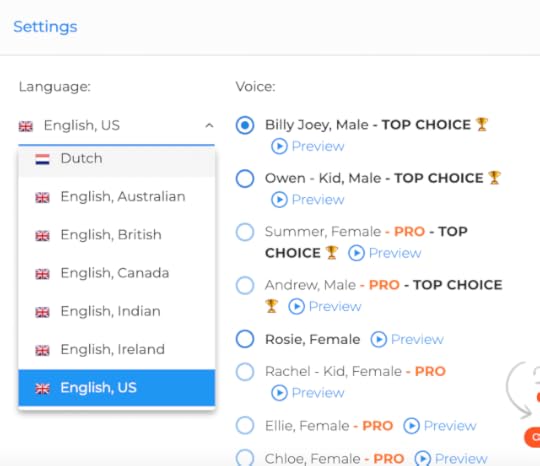
Now that you've selected your voice for the audio file, paste your text into the box, up to 5000 characters at a time. If you have more than 5000 characters in your text, you will need to stitch your audio files together with editing software.

Tip: You can use the Podcast function in Soundtrap to stitch together your audio files. You can also upload your audiobook directly to Spotify by using Soundtrap.
Once you have pasted your text in to Speechelo, you can either preview the voiceover to listen to the AI reading. At this point, you have the option to edit the text - you can add breathing to make it sound more natural, you can prompt the text to emphasize certain words, adjust the speech or add a pause, by using the commands below:

Once you are happy with the way the audio sounds, press generate voiceover.
Click on the download button below and it will ask you if you want to add background music. I always say no to this. Click no just download and it will automatically download an mp3 file of your AI reading.
Top uses for writers to use AI to create an audiobook to read their poetry or novel:Upload your audiobook to your website so that people can hear a sample of your novel. You might have to use an audio or video hosting platform like Soundcloud or even YouTube - as I've done above!create a poetry reading
create social media posts of the blurb of your story, snippets from the text (pick your best lines here), or poetry. Create the audio file in Speechelo and then use video editing software such as Vimeo, iMovie (on an iphone) or other application and then use an image or video to go with the beautiful-sounding reading!
Create an NFT of AI reading your book or poetry along with interesting imagery or a video. You could use a service like Fiverr to help you create an original NFT to sell on an NFT platform.
The possibilities are endless when you use Speechelo to create an audiobook of your novel. Have fun playing around with the different AI voices - they sound far more natural than other text-to-speech voices out there. And start getting your novel or poetry out as an audiobook for people to listen to!
AI is developing and improving every day and can be a useful tool for authors. You can also check out our recent post Can AI help you write a novel?
March 29, 2022
Best Audiobooks For Writers To Learn The Craft Of Writing

Writing can be challenging. One minute you have this grand idea in your head and you can picture selling millions of copies. The next, you’re struggling to put your idea to words and pages. While this is not always the case, listening to the best audiobooks for writers is a perfect way to craft your skills and get back on track.
In recent days, learning, as we know, has taken a different route from the traditional system to a simplified, modern and convenient style. So, for example, you can learn creative learning from the comfort of your home by listening to audiobooks. In addition, you get to learn from published authors, poets and so on, just as you would have in a lecture setup.
This article will focus on the best audiobooks for writers to help you master your craft. You will be learning from famous authors and editors how to channel your thoughts and passions into solid words and build an author’s mindset, among other secrets. Additionally, although writing has its challenges, you will learn that not giving up is the best decision you will make.
Why Is It Important for Writers to Listen to Audiobooks?1. Learning from ExpertsAudiobooks by famous writers and editors expose you to information, tips and hacks to craft your skill. In addition, published authors teach from their own experience, sharing problems you may encounter and how to tackle them. In turn, aspiring writers can learn to translate their words and thoughts onto paper.
2. ConvenienceWriters juggle so many things on a day-to-day basis. This could be working a full-time job, running a business, taking care of your family or having a social life. Yet, more often than not, learning the craft of writing hardly makes it on your to-do list.
Audiobooks ensure that you keep up learning as you go about your day. Unlike reading which needs your eyes glued to the book, you can listen to an audiobook while doing another activity simultaneously.
3. AccessAlthough we love a good book shopping spree, having access to a book when you want it is not always easy. Fortunately, listening to top books for writers is just a few clicks away with an audiobooks platform like Audible. Additionally, you may find these audiobooks to be more on the affordable end, and you can try the first month for free!
 Best Audiobooks for Writers
Best Audiobooks for WritersThe audiobooks mentioned below share a wealth of knowledge for writers, whether you are an aspiring, beginner or experienced writer. These audiobooks will guide your writing process, from a hot idea to the first draft and subsequent edits.
However, it’s important to consider your career level and preferred genre before getting into any audiobooks below. This is because romance writers, for example, will have different needs from non-fiction writers. In addition, each book will meet different career stages, with some focusing on outlining, self-editing and self-publishing.
With that in mind, below are the best audiobooks every writer should listen to.
1. A Swim in a Pond in the Rain, by George SaundersGeorge Saunders is a best-selling author of short stories, novellas, essays, novels and children’s books. His works have been published in magazines like GQ, Harper’s, McSweeney’s and The New Yorker.
George Sanders shares seven essays to educate writers on how fiction works in seven short stories by great Russian authors such as Chekhov and Tolstoy. He also takes a look at Gogol's famous story 'The Nose'.
George Saunder’s technical approach gets writers to look closely at what gets readers engrossed in a story and what doesn’t. In A Swim in a Pond in the Rain he talks about how his revision technique is often at the line level, and every time he shows up, he is bringing something new to revising his story. He says, a writer's revision is:
'... you happy, you grouchy, you stern, you euphoric, you blurry, you precise, and so on. Your intuition will have been given thousands of chances to do its best work. That's how I see revision: a chance for the writer's intuition to assert itself over and over.'
2. On Writing, by Stephen KingStephen King is arguably one of the world's best-selling authors of our time. Over the years, his prolific writing style has earned him success and the name master of terror.
The book On Writing, part memoir part stylebook(instructions), talks about Stephen King’s struggle with alcohol and drug addiction and getting his family out of poverty. He talks about writing his first draft and throwing it in the bin only for his wife to pick it up and encourage him to keep going.
The book also offers advice on technical aspects like developing the plot, characters and even facing a blank page. According to King, you have to come to terms that a lot of your work will be rubbish. However, you will improve your writing skills as you revise and work on your draft.
3. Zen in the Art of Writing, by Ray BradburyRay Bradbury is one of the most celebrated writers of the 20th century. With works in different genres like horror, realistic fiction, science fiction, fantasy and mystery, there’s a lot to learn from this author and screenwriter.
The book Zen in the Art of Writing focuses on the joy and beauty in writing. Ray Bradbury shares his infectious joy in the art of writing, prompting the reader to think of Shakespeare and Melville.
Although writing is challenging at times, this audiobook urges writers to find joy when creating. The book adds that you’re only half a writer if you write without zest, gusto and love.
4. On Writers and Writing, by Margaret AtwoodMargaret Atwood is a phenomenal writer with various titles, such as poet, novelist, literary critic and essayist. Some of her works include The Handmaid’s Tale and Alias Grace. In addition, she has also been a teacher, an inventor and an environmental activist.
Margaret Atwood reflects on her childhood and writing career in On Writers and Writing, examining roles, metaphors and costumes that writers of fiction and poetry have assumed. In addition, the book references living and dead writers and examines the art of writing as a gift.
This audiobook sparks reflection among beginners and experienced writers. The questions “What is a writer? And For whom do writers write?” prompt writers to seek clarity about their purpose of writing. In turn, writers get to experience the pleasure that comes from this unique art.
5. Stein on Writing, by Sol SteinA renowned author, editor and instructor, Sol Stein shared many writing gems in his books. His works are a great refuge for writers in all stages of writing.
Stein on Writing is a writing masterclass. Unlike other theoretical books on writing, Sol Stein offers usable solutions to improve your skills. These include fixing flawed writing, improving good writing and creating interesting writing.
Fiction and non-fiction writers can learn a lot from this book, from writing techniques like pacing and dialogue to characterization and flashbacks. In addition, aspiring and professional writers can learn to use the triage revision method and fiction techniques to bring life to non-fiction works.
6. The Emotional Craft of Fiction, by Donald MaassDonald Maass is a fictional writer and literary agent. He shares valuable lessons about writing based on his career with several titles to his name.
The Emotional Craft of Fiction is about using emotion to engage your readers. Donald Maass emphasizes that writing great fiction makes the readers feel something instead of just reading. While this is a debatable subject among many writers, this book reiterates the importance of a reader’s experience as an emotional journey similar to your character’s journey.
This book teaches writers to use stories to evoke emotional feelings in their readers. By learning different emotional writing modes and how to connect inner and outer journeys, writers can make their stories an experience for their readers.
7. On Writing Well, by William ZinsserWilliam Zinsser was a writer, editor, teacher and literary critic whose works have been used to teach writing worldwide. He started his career as a New York Herald Tribune journalist and went on to teach non-fiction at Yale.
His book On Writing Well is a must-read for non-fiction writers, including bloggers. The book covers various topics like mastering your author's voice, narrowing down your perspective and analyzing what works and doesn’t. In addition, you will find a few practical English writing tips that will come in handy in your next piece.
From this audiobook, non-fiction writers can learn the importance of bringing their point across to the reader. William Zinsser says this is more important than focusing on word choices and grammar.
In ConclusionListening to the best audiobooks for writers can immensely help hone your skills. The audiobooks shared above are a must-listen for writers as they offer valuable tips and lessons from the authors’ personal experiences. Follow this LINK to get an Audible Plus free 30-day trial if you're ready to improve your craft. In addition, you can listen to the Audible audiobooks for writers for free!
________________________________________
Sign up to receive a free 7-step action plan to become a published author!
-improve focus and productivity
-must-have writing software
-agents and publishers seeking manuscripts
#mc_embed_signup{background:#fff; clear:left; font:14px Helvetica,Arial,sans-serif; } /* Add your own Mailchimp form style overrides in your site stylesheet or in this style block. We recommend moving this block and the preceding CSS link to the HEAD of your HTML file. */
SubscribeMarch 6, 2022
Scrivener vs The Novel Factory - novel writing software
 What is novel writing software? Novel writing software is special writing software designed for writers who are writing a novel. It’s designed to help you organize your story, keep track of characters and locations, and enable you to write quickly without having to worry about organizing your work.
What is novel writing software? Novel writing software is special writing software designed for writers who are writing a novel. It’s designed to help you organize your story, keep track of characters and locations, and enable you to write quickly without having to worry about organizing your work. If you’re serious about writing a novel, then you should consider buying some novel writing software. There are a few different novel writing software programs available on the market.
Here I’m going to review two different programs for authors, one that I think is for advanced novelists and one that I think is good for beginner writers who want help with writing a story.
After over 15 years of writing novels, I’ve found that Microsoft Word no longer makes the cut and that it is far easier to manage my manuscript by using novel writing software.
Let me introduce you to Scrivener and The Novel Factory and what I consider to be the best novel writing software.
Novel writing software reviewScrivener Scrivener is one of the earlier novel writing software programs available. It is incredibly effective at helping you to keep your manuscript organised.
I first heard about Scrivener in a podcast So You Want to Be A Writer by the Australian Writers Centre. They were talking to E. Lockhart about how she wrote the structurally complex novel 'We Were Liars.' I absolutely loved that novel, and was in awe of how it switched between time seamlessly. Lockhart said that she likes using Scrivener because it allows a writer to rearrange whole chunks of their story easily.
I went to Scrivener website and downloaded it straight away. At a one-off fee of $77, which includes any upgrades, it's far more cost effective than other subscriber model novel writing software on the market. It is one of the best novel writing software for Mac or Windows.
So what does Scrivener do?
Scrivener allows an author to plan out their novel by writing notes for each chapter. Writers can then flesh out each chapter as they go along.
It also has the ability to zoom out and see a corkboard for each chapter as an overview - so an author can easily see a snapshot of all parts of their novel.

Users can easily drag and drop their chapters to rearrange sections easily. Realise that a chapter needs to be moved to later in the story? Easy. Just drag and drop the chapter there!
Scrivener encourages you to break your novel into smaller segments, which makes it easier to focus on one section at a time.
There are pre-built character sketches that you can fill out to assist with your character development. You can even pop in an image of what you think your character will look like!
Ways that Scrivener can help you write your novel:
- Outline tool: The corkboard feature creates a visual outline of your novel. This can help you to see how your story is progressing and make sure all the elements are in place.
- Writing tool: You can use the editor to write your novel. The split screen feature allows you to see your manuscript alongside your notes and research, so you can easily reference them while you write.

- Create character profiles and track their arcs throughout the story. Do you struggle with how to develop a character in your novel? Use the question prompts to better imagine your character. Pop a photo in there to keep you on track with character descriptions.

- Keep track of scene ideas, quotes, and other notes related to your novel
- Store research materials related to your novel in one place. See them easily as you are writing your novel
- Publishing tool in Scrivener. Export your finished novel as a PDF or Word document. You can even choose to export it as a paperback or proof copy. This is one of the easiest ways available to create an ebook cheaply.
The more I use Scrivener the more impressed I am. This is the best writing software on the market right now, and it's only going to get better. And you always get the upgraded features, without having to pay more!
Scrivener is great for experienced writers who want more control over the structure of their novels
You can check out Scrivener here.
The Novel Factory
The Novel Factory has researched all the necessary elements of a great novel and developed inexpensive software that gives writers a clear step-by-step guide to help them write their novel.
Subscribers get a clear roadmap to start and complete their novel in 15 steps. From the initial idea (the premise), through to outlining the plot, character development, scene blocking, first draft, locations, subplots, through to the final draft - Novel Factory will guide you through each stage.

The Plot Manager is one of the best features in The Novel Factory - giving writers actual plot templates to work with! This is genius - as it guides them through the most important elements needed in classic types of stories such as the Hero's Journey, Romance, Mystery or Detective.

Once a template is chosen, The Novel Factory offers typical elements that happen in each part of the novel, breaking scenes into Act I, II and III and then pre-fills index cards to help guide the writer further.

The Novel Factory acts like a writing tutor as you go along.
The Novel Factory features that help you write a novel include:
- Character profiles: create detailed profiles for each of your characters, including their biography, physical description, and personality traits.
- Plotting: get help plotting your story using the built-in templates
- Fill out character profiles, including physical description, biography, and personality traits
- How to write a novel, step-by-step guide. The Novel Factory takes you through each of the novel writing stages, so you won't feel lost or overwhelmed.
You can find out more about The Novel Factory here.
Is Scrivener or The Novel Factory better for helping a writer write a novel?
Well, it depends really.
I think that Scrivener is great for writers who already understand the basic elements of storytelling. It’s no-fuss software that focuses on allowing authors to plan out each chapter easily, zoom out and see their story as a whole and drag and drop sections at a time. It has an easy ‘compile’ function that pieces the whole story together at the end.
I consider Scrivener to be the best novel writing software. I literally plotted out a whole novel in one day, using the notes and corkboard features in Scrivener. While the novel took a year to write, that one day of planning in Scrivener guided the whole process and allowed me to write a novel knowing clearly where the story was heading.
I think that The Novel Factory is good for new writers, or writers who are struggling with plot. It helps writers who are learning how to construct a story and need to be guided along. The videos are very helpful at explaining the necessary elements of a good story and can be like a writing course on steroids!
However, at $77 for a one off fee, plus all the upgrades, Scrivener is also more cost effective software than The Novel Factory that is about $198 a year if you have more than one novel. Getting Scrivener means you are not locked in to monthly or yearly payments. It's your software for your novel. Always.
Good luck! See how novel writing software can change your writing life!
_________________________________________
Sign up to receive a free 7-step action plan to become a published author!
-improve focus and productivity
-must-have writing software
-agents and publishers seeking manuscripts
January 3, 2022
Become a better writer using AI writing software

This article was written by AI writing software - I will tell you which one at the end!
If you are a writer and have ever thought about using artificial intelligence to help with writing your stories, articles, website content, blogs or whatever else it is that you write, then this article is for you. In this article I will explain exactly what Artificial Intelligence (AI) can do for you and which one is the easiest to use.
What is Artificial Intelligence and how can it help you become a better writer?In the simplest terms, AI is a computer program that has been designed to think and act like a human. It can learn, make decisions and complete tasks just like a human would. This technology has been around for decades, but it has only recently started to take off.
If you are running a blog, then you should know that there is no need to hire an expert writer anymore. The reason is that there are simplified artificial intelligence applications available in the market today which can help you create blog posts faster and more efficiently than any human writer can.
A simplified artificial intelligence application can be defined as an application that uses the latest algorithm and technology to perform the work of a human writer. It is capable of completing tasks such as writing sentences, extracting information from a web page or even analyzing data.
So let's take a look at some of the AI writing softwares out there. And at the end, I'll tell you which one helped me write this entire post!
 Jarvis AI writing software
Jarvis AI writing softwareJarvis AI uses the power of Artificial Intelligence to create custom content, but it is smart enough to know when you are writing, and when it should step in. The program can then help you write your content with ease, and you’ll find yourself creating more content than ever before.
Jarvis AI can also help you gain more followers by producing better content for social media, and generating more traffic.
You can read my recent post on Jarvis AI - Can AI help you write a novel?
Find more about Jarvis AI here.
AI Writer writing softwareThere are a lot of great tools out there that help you write content faster. However, these tools do not always produce high-quality content. At best, these tools can come up with mediocre writing that needs to be edited by a human writer. Other times, the writing produced is just plain bad and doesn’t need much editing at all.
AI Writer is different because it produces content that is so good, you will think it was written by a human writer. It does this by learning about your company’s voice and style, then replicating it in its writing.
Unlike other AI writing software, AI Writer can be used to create both long and short pieces of content. It can be used for anything from writing a blog post for your business, to writing an article for your website, or even creating a book.
The biggest factor that makes it different is the ability to save your content as a word file, and edit it as you would any other piece of content. The added benefit of using AI Writer is that you will have a more natural sounding voice in the text, due to the advanced algorithms used to create it.
Find more about AI writer here.
Simplified AI writing softwareMost AI software works by scanning your content for keywords, and then deciding a response. This usually leads to a glaringly obvious pattern in writing, which results in spammy, repetitive content.
Simplified AI has been specially designed to overcome this problem. It is unique in that it uses natural language processing to understand the context of your content and respond naturally with relevant information.
Find more about Simplified AI here.
Copymatic AI writing softwareCopymatic has a few key differences to other AI writing software that make it more useful for businesses who want to automate their content creation.
Copymatic is the first ever AI-based software that can write high-quality content for you. It does this by creating a unique personality for each article and mimicking real human writing style. Copymatic can be customized to fit the voice of any business or brand, and even named like an employee. Copymatic’s writing style is very similar to that of a human writer. It doesn’t use keyword stuffing, and it uses complex sentences with active verbs. Copymatic also writes content in a way that is easy to read and understand.
Copymatic is a human-quality writer that is ideal for creating content for websites, blogs, or other online platforms. It has a variety of topics it can write about, and it will even create an entire article for you based on a keyword. You can also have it write about a specific topic, and it will follow your guidelines.
Find more about Copymatic here.
Anyword AI writing softwareAnyword uses Artificial Intelligence (AI) to help content creators write better, more engaging content that gets twice as many views than the average.
Staggering statistics show writers are struggling to find the right words, with over half of all writers citing it as their number one problem. Anyword can help by using AI to pick out the best words, phrases and sentences to create engaging and interesting content.
Anyword is the most advanced AI writing software in the world. It’s a unique combination of the best technologies from three different domains, including NLP, Machine Learning and Computer Vision. Anyword uses a unique algorithm to find the best possible answer for a given question by analysing millions of posts across all social networks. This question is then passed to an NLP engine that extracts any and all relevant nouns, verbs, adjectives and adverbs from the question.
Should you fact check AI writing?People are scared of AI because it seems like robots will take over the world. To quell their fears, you should fact check AI writing. Here are three examples of when you should fact check AI writing:
- If you need to write something that is objective, or has to do with things like facts or events, it’s better to let a human do that job.
- If you have a long and complicated piece that may have some mistakes in it, let humans take care of it instead of machines. Also, if you have a piece that is very long and detailed and also has lots of images, it’s better to let a human do the job.
- If you have a piece that is very short and has only one or two images, then it’s probably okay to let a machine write it.
In the near future, AI will be writing and publishing content in a lot of places. Fact checking content will ensure that your brand isn’t associated with any misinformation, or at least give you the opportunity to correct any mistakes before it gets out into the world. Fact checking AI is no different than fact checking any other type of content. It’s more work, but it’s worth it.
One third of the news in Bloomberg has been written by AI reportersIt is interesting to note that roughly a third of the content published by Bloomberg News uses some form of automated technology. Bloomberg uses AIs to generate stories about company earnings and other data-driven topics. The AI also has the ability to generate news stories based on data collected from other media.
While Bloomberg is using AI to help produce content, it is still up to humans to determine what makes a good story. The human editors and reporters are responsible for making sure the stories are accurate and balanced.
It is easy to see how this technology could be used to replace human reporters. After all, the technology can produce news stories faster than a human can write them. The real question is whether the public would accept news stories written by a machine.
Can AI write a novel?In a recent article in the New York Times, the author wondered if a computer could write better fiction than humans. He mentioned that AI had already beaten us at chess and Go, and he saw no reason why it wouldn’t be able to beat us in writing as well.
He was right. Artificial Intelligence is already capable of creating compelling stories that are hard to distinguish from human ones. In a study published in Nature, researchers from the University of Montreal showed that they could create a machine-written story that was so realistic that it fooled more than half of the people who read it.
You can read my post recent post Can AI help you write a novel? - where I tested Jarvis AI to start a creative story - and the results were amazing!
So which AI writing software wrote this piece?Simplified AI. It's incredibly easy to use. I really like how you can write a sentence, like a heading or question, and then highlight it and select 'write section'. A few different options are generated in the right hand panel and you can select your favourite.
You can also highlight and select expand, continue section or rewrite. I also like how you can select which part of a blog post you are writing - eg, the heading, the introduction, an outline, a conclusion.

It is also less expensive than other AI writing software programs. To access the long form writer you will need the business plan, which starts from $30 paid monthly, or $24 yearly.
Simplified AI wrote the review text on each of the AI writing software programs featured here - so see what you think. Did it do a good job?
November 30, 2021
Which publishers accept manuscripts

These are the three best resources for finding a publisher. And it has taken me years to find them! Now, I'm going to share them with you!
After hard work and dedication (and endless hours of struggle), you have finally finished your manuscript! Or perhaps you aren’t quite done, but you are close enough that it is time to start thinking about the next step. No matter where you are in the writing a novel process, it will be useful to make a plan of action for your finished manuscript.
There are, in fact, some editors from traditional publishers looking for new authors. Some publishing houses even have open submissions.
Sure you can do a google search for:‘publishers accepting submissions’ ‘publishers accepting unsolicited manuscripts’
The Google search works well. That is how I started. I’ve sent off many manuscripts by finding publishers such as Penguin or HarperCollins who have open submission processes via Google.
However, after 15 years, I’ve finally discovered three excellent resources that I now use to find publishers who accept unsolicited manuscripts.
1. Duotrope Duotrope is an award-winning resource that has a great search tool for writers to find literary agents and publishers accepting unsolicited manuscripts. Writers can also track their submissions within the software.
From $7.50 a month you get access to an incredible search engine of literary agents and publishers accepting submissions.
For fiction writers, you type in the genre you have written, the style (eg literary, fantasy, mystery etc), the audience (young adult, commercial etc), the length (novel, novella, short story etc) and the number of words. You can also select publication medium (print or digital).
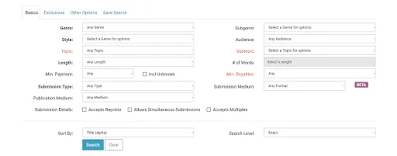
You can then sort the results by the response time of those literary agents or publishers or even by the acceptance percentage! You can also save your searches, to come back to later.
In the submissions tracker you can record who you sent a particular novel to and what date. You can then come back to this and note if the manuscript was acknowledged, accepted, or rejected, or never responded.
Check out Duotrope here.
2. Manuscript WishListManuscript WishList is a fabulous resource to find publishers and literary agents who are accepting manuscripts.
Go to the genre search https://www.manuscriptwishlist.com/find-agentseditors/search/.
Select either agent or editor and the genre (fiction and non fiction genres available).

The ManuscriptWishlist will then give you hundreds of agents or editors to search through. Click into each profile and read their bio, as well as a description about the type of manuscripts they are interested in. This information is invaluable. You can quickly tell whether they would be interested in the type of manuscript you have written.
There is also information about each literary agent or publishing editor's submission guidelines and links to their website or email for where you can find out more information about submitting your manuscript.
This has seriously been an absolute gem in finding literary agents and publishers to submit my manuscript to.
Check out Manuscript WishList here.
3. Writing Tips Oasis
I don’t know how they do it, but Writing Tips Oasis has some of the best lists of publishers accepting unsolicited manuscripts that I have come across.
They seem to be constantly updating their lists and also have really niche lists such as:
21 Australian publishers accepting unsolicited manuscripts19 Top Publishers for First Time Authors
I love how they really narrow down their lists of publishers open for submissions for authors.
Find the search bar and type in your book’s genre and see which lists Writing Tips Oasis comes up with. They may even have lists of publishers to find in your country.
Check out Writing Tips Oasis here.
So, along with Google these are my top 3 resources for authors looking to submit their manuscripts. These are great resources for finding the right publishers. And remember, to keep track of your submissions. Use Duotrope, or a basic spreadsheet. Track the name of the publisher, the date and the response. Even if you get a lukewarm response, track it. You can send a new manuscript to that editor and say ‘remember me’.
If you’re a serious writer, you’ll have years of submitting ahead of you. So get a system in place. Learn about how to construct the best type of query letter. Listen to the Manuscript Academy podcast. They have agents reading out query letters and responding to them in real time. The Manuscript Academy is by the same people as the Manuscript WishList – and their podcast is brilliant at teaching writers how to write the best query letter possible. Sure, you’ve written a book, but the query letter is even more important! So you need to get it right.
I hope you now have a few resources under your belt to start submitting your manuscript.
Good luck with it!
_________________________________________
Sign up to receive a free 7-step action plan to become a published author!
-improve focus and productivity
-must-have writing software
-agents and publishers seeking manuscripts



